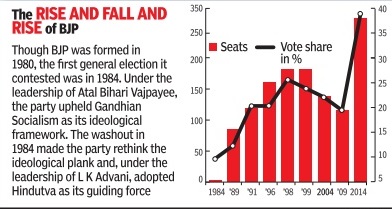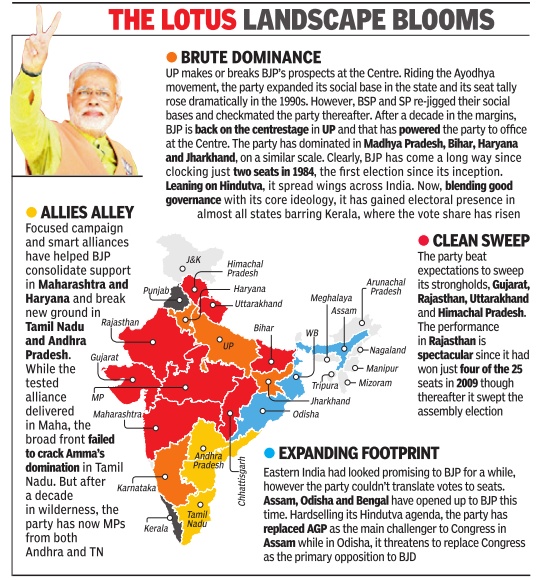Bharatiya Janata Party (BJP)
| Line 34: | Line 34: | ||
=Growth across the nation= | =Growth across the nation= | ||
[[File: BJP rides wave.jpg| BJP rides wave. In addition, BJP won both seats in Jammu and the lone seat in Ladakh. |frame| 500px]] | [[File: BJP rides wave.jpg| BJP rides wave. In addition, BJP won both seats in Jammu and the lone seat in Ladakh. |frame| 500px]] | ||
| − | [[File: | + | [[File: bjppp.jpg|BJP in India: 2009-2014, Graphic curtesy, [http://indiatoday.intoday.in/story/assembly-elections-maharashtra-haryana-bjp-narendra-modi-amit-shah/1/397171.html ''India Today'']|frame|500px]] |
''' BJP rides wave to make inroads into new states ''' | ''' BJP rides wave to make inroads into new states ''' | ||
Revision as of 11:52, 25 March 2015
This is a collection of articles archived for the excellence of their content. |

Contents |
Election results 2014: BJP landslide shatters four electoral myths
Milan Vaishnav
The Times of India| May 17, 2014
The 2014 elections have only just ended but analysts are already struggling to comprehend how the BJP's stunning electoral success, deemed unlikely just one year ago, came to pass. The results of India's sixteenth general election challenge our common understanding of contemporary Indian electoral politics in at least four ways.
BJP can't go beyond its traditional strongholds
First, the conventional wisdom was that the BJP was trapped by its traditional political and geographic boundaries, deemed insurmountable thanks to the party's Hindutva agenda. Yet, the BJP has garnered an estimated one-third of the all-India vote, a massive improvement from 19% in 2009 and its all-time best of 26% in 1998. This improvement was driven by sizeable vote swings in critical Hindi heartland states as well as smaller but significant gains in the South and East, neither an area of traditional strength. These gains were possible thanks to Modi's persistent focus — in the national theatre of politics — on development and economic mobility. This message aligned perfectly with the issues vexing most Indian voters; a post-poll conducted by CSDS found that in every state surveyed, voters identified development, inflation or corruption as their most important election issue. To be clear, the BJP's saffron agenda has not vanished; recent campaign rhetoric and the party's manifesto confirm this. Yet, going forward, deviation from the focus on governance and development could imperil these newfound gains.
It can't stitch up alliances better than Congres
A second assumption that was upturned in this election was that Congres, not the BJP, had the advantage in alliance formation. Despite all the talk about its off-key "India Shining" mantra sinking the BJP in 2004, their loss was more about the BJP's inability to forge the right alliances. This fed doubts about whether the BJP could construct effective alliances in 2014, especially with Modi at the helm. Yet it was a Modi-led BJP that struck key deals over the past several months while the Congres, in contrast, was viewed as a sinking ship. Many observers dismissed the BJP's alliance with the Lok Jan Shakti Party in Bihar, the Telugu Desam Party in Andhra Pradesh, and the Haryana Janhit Congres as trivial. But such criticism overlooked the importance of small shifts in vote share in a fragmented, first-past-the-post electoral system.
Support for regional parties is growing
A third assumption underpinning Indian elections since 1989 has been the growth of regional parties. Between 1996 and 2009, the non-Congres, non-BJP share of the vote has hovered around 50%, rising to a record 53% in 2009. The 2014 election, though, saw a decline in regional party support; their nation-wide vote share dipped to roughly 47%, reversing the prevailing trend. Two players merit special attention here. The first is the evisceration of the BSP. Mayawati may draw a blank in Uttar Pradesh while the hard-fought inroads she made in other Hindi heartland states simply evaporated. The second is the weakening of the Left. At a time of rising inequality and concerns over crony capitalism, the conditions would seem propitious for a Leftist revival; instead we are witnessing their collapse.
Lok Sabha polls are a sum of state verdicts
A fourth assumption has been that national elections are best understood as an aggregation of state verdicts. The 2014 election outcome, however, is a partial reversal of "derivative" national elections. Not only was this election marked by presidential overtones, but the animating issues—namely, the slumping economy—have also been pan-Indian. Despite this apparent shift, there are two caveats to the "nationalization" thesis.
First, states still remain the most important tier of government for ordinary Indians. This is reflected in the fact that, notwithstanding the record voter turnout in these Lok Sabha polls, turnout for state elections is still 4.5% higher, on average, in any given state. Second, much of the south remained resistant to the BJP's charms. Although the BJP picked up new seats in Andhra Pradesh, Karnataka, and Tamil Nadu, its advances were limited and much smaller than in the north.
(The writer is an associate with the South Asia programme at the Carnegie Endowment for International Peace in Washington, DC)
Growth across the nation

BJP rides wave to make inroads into new states
The Times of India May 17 2014
BJP's stunning breakthroughs, despite organizational weaknesses and geographical limits, in states like Haryana, Assam, West Bengal and Tamil Nadu speak of the strength of the Modi “lehar“ and provide an opportunity for future consolidation.
BJP leaders were themselves surprised by the response to Narendra Modi in these states where the party has had minimal presence or had atrophied over the years due to organizational neglect.
In Haryana, such was the voter anger against the Hooda government in the state and the Congres regime at the Centre that BJP won 7 seats and 33% of the vote despite some poor candidate selection.
BJP did not go for an alliance with Om Prakash Chautala's INLD due to cases pending against the Jat leader and its pact with Kuldeep Bishnoi's Hayana Janhit Party did not, on paper, command a wide social base. But despite the BJP-Bishnoi pact lacking Jat support, the community voted in large numbers for a `Modi sarkar' ignoring competing claims of Chautala and Hooda.
In fact, the impressive response to Modi's first rally in Rewari after being named BJP's PM candidate set the tone and BJP pulled in votes from almost all sections.
In Assam, as in Haryana with regard to INLD, BJP's decision to avoid an alliance with AGP paid off handsomely . Modi clearly struck a rich vein when he articulated a deep groundswell of resentment against illegal migration and simmering ethno-religious tensions as the seven seats and a 36% vote share indicate.
BJP and its ally PMK won a seat each in Tamil Nadu, riding on its status as the frontrunner. Modi's rallies, despite the language barrier, were well attended and it was the first time since Rajiv Gandhi that a leader from the north became a talking point.
The decision to take on Mamata Banerjee by slamming her “poriborton“ as a sham and raking up the illegal migrants issue was an inspired one as it pitched Modi into the centre of the discourse in West Berngal. The two seats BJP won in the state seem modest, but represent a breakthrough with almost 18% of the votes.
